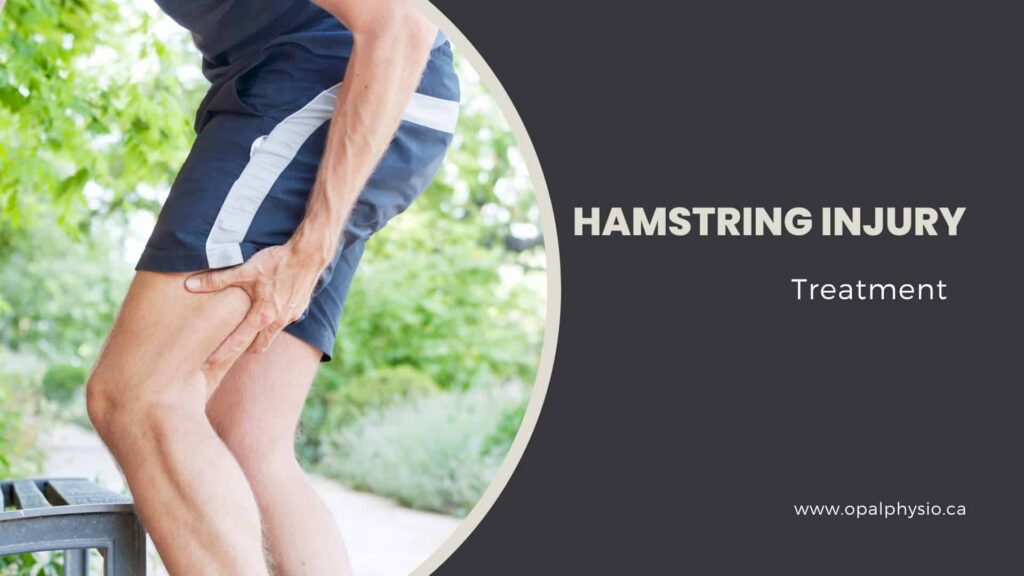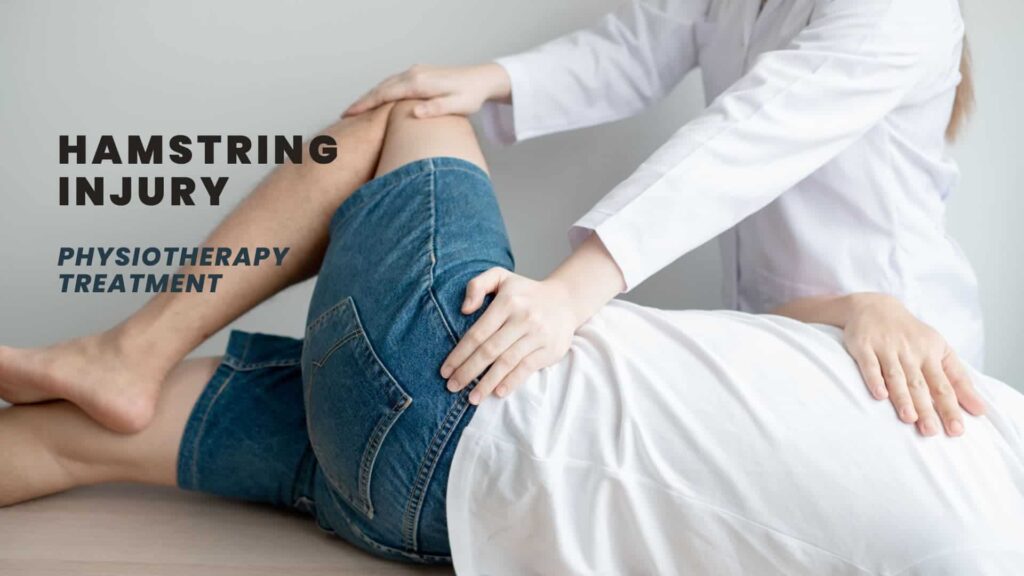Hamstring Injury
A common injury in contact sports is a hamstring muscle strain or tear (“hamstring pull” or “pulled muscle”). Hamstring Injury is usually induced by a sudden stretch or contraction of the hamstring muscle or by a direct blow to the hamstring muscle. The most common symptoms are pain felt on the back of the thigh and discomfort while trying to walk, run or stretch.
Hamstring strain treatment
Physical therapy exercises are essential in the recovery process, as they help to strengthen the hamstring muscles and improve flexibility. You should consider getting physical therapy for a hamstring strain or tear to help speed up recovery and alleviate symptoms.
Physical therapists at Opal Physio can help you manage your pain and prescribe exercises to help you recover your overall mobility, range of motion and strength after a hamstring injury.

The hamstring muscles are the semimembranosus, semitendinosus and biceps femoris. These muscles span along the posterior thigh from the hip to the knee. The essential function of this muscle is to help bend your knee and extend at your hip. Your hips and knees make up the central point of your musculoskeletal system, and these muscles help with several functions in your locomotion, like walking, running and climbing stairs.
Hamstring strain
A hamstring strain is an injury to one or more of these muscles and is common in sports such as soccer, sprinting, kicking, or any other high-speed movement where there is sudden stopping and starting.
A sudden, quick movement that exceeds the muscle’s range of motion or strength causes muscle injury. Some causes of this injury may be impacted by a direct blow to the back of your legs, quickly rising from sitting to standing, and falling on uneven ground.
Types of hamstring injuries
Hamstring injuries are most commonly caused by excessive stretching of the muscle group or from a sudden, powerful contraction of it. Hamstring tears can range from a complete muscle tear to a mild strain. These can include
Grade 1 hamstring strain
- Mild muscle pull or strain
- Minor tearing of muscle fibres
- Usually heals within 2-3 weeks with proper treatment
Grade 2 hamstring strain
- Partial muscle tear
- More extensive muscle fibre damage compared to grade 1
- It takes around 4-8 weeks to recover.
Grade 3 hamstring strain
- Complete muscle tear or rupture
- Severe damage to muscle fibres and connective tissue
- It takes 2-3 months to heal
Avulsion fracture
- The hamstring tendon pulls away a piece of bone where it attaches
- It happens at the ischial tuberosity (sit bone)
- Significant pain and disability
- Requires surgical treatment and long recovery
Symptoms of hamstring injury or strain:
Here are the common symptoms of a hamstring injury or strain:
Mild hamstring Strain (Grade 1)
- Sudden, sharp pain in the back of the thigh
- Tenderness in the hamstring muscle
- Pain when bending or straightening the leg
- No loss of strength or function
Moderate Hamstring Strain (Grade 2)
- More severe pain and tenderness compared to grade 1 strain
- Noticeable loss of strength and function in the leg
- Bruising, swelling, muscle spasms
- Popping or snapping sensation when injured
- Difficulty walking normally
Severe Hamstring Strain (Grade 3)
- Severe pain, tenderness, swelling, and bruising
- Significant loss of strength and function
- Muscle spasms and cramping
- Bruising down to the knee
- Popping or snapping sensation
- Unable to walk without pain
- May require crutches or immobilization
The severity of symptoms depends on the extent of muscle tearing. Proper diagnosis, treatment, and rehabilitation are essential for recovery. Recurring hamstring strains are common without proper care.
Causes of hamstring injury:
The most common reasons are:
- Acute trauma to the back of the leg
- Overuse
- Sudden movements such as sprinting or kicking
- Repetitive bending of the knee for an extended period
Treatments for hamstring injury or strain:
There is no one treatment for hamstring injuries or strains. Hamstring injuries are usually acute, but chronic strains can also develop.
Treatment varies depending on the injury’s severity or strain, including rest, ice, heat, NSAIDs, stretching exercises, and physical therapy.
Treatment for a hamstring strain or tear can vary from conservative management to surgical treatment and rehabilitation.

Physiotherapy for hamstring injury treatment.
Physiotherapy helps with hamstring injury rehabilitation by working on flexibility and strength. It consists of techniques to rehabilitate the muscle, restore it to its original length and range of motion, and reduce pain and Inflammation. These benefits improve the quality of life of patients with hamstring injuries significantly.
Physiotherapy can help the injured person recover from the injury and reduce their chances of re-injury. Therefore, starting PT soon after a hamstring injury is essential to prevent it from becoming chronic.
Your physio treatment at Opal Physio of your hamstring strain will include the following:
Acute phase (First 1-2 weeks)
- RICE – Rest, Ice, Compression, and Elevation to reduce pain and swelling
- Gentle range of motion exercises like knee extensions and hip flexion
- Avoid stretching the injured muscle
- Use crutches if needed to avoid weight-bearing
Subacute Phase (2-6 Weeks)
- We will begin gentle hamstring stretches and mobility exercises.
- Start introducing strengthening exercises like bridges, leg raises, and resisted knee flexion.
- Use eccentric exercises to rebuild muscle strength.
- Add core and pelvis stability exercises.
- Use myofascial release for swelling and scar tissue.
- Progress to balance and proprioception exercises.
Return to sport phase (6+ Weeks)
- Continue hamstring stretches and strengthening.
- Focus on eccentric exercises and plyometrics to prepare tendons.
- Initiate agility drills, jogging, sprinting, and sport-specific exercises.
- Emphasize progressive loading and monitoring for reactions.
- Taper training to peak for competition.
- Use preventative strategies like warming up and taping.
Your physiotherapist will also advise avoiding any aggravating activities that cause pain or prevent the healing of hamstring tissue. You will also receive exercises for home management to continue to help with the recovery.
The exact rehabilitation plan should be tailored to the individual based on injury severity, goals, and sports demands. Our physiotherapist can guide the optimal exercises and progressions for each stage of recovery. The main objectives are to resolve pain and swelling, restore range of motion and strength, retrain neuromuscular control, and gradually return to sports to prevent re-injury.
Hamstring injury treatment in Langley
If you have been diagnosed with a hamstring injury or if you think you have one, contact our physiotherapist at Opal Physio, Langley, to start the recovery process so we can help treat the pain and restore your function.
